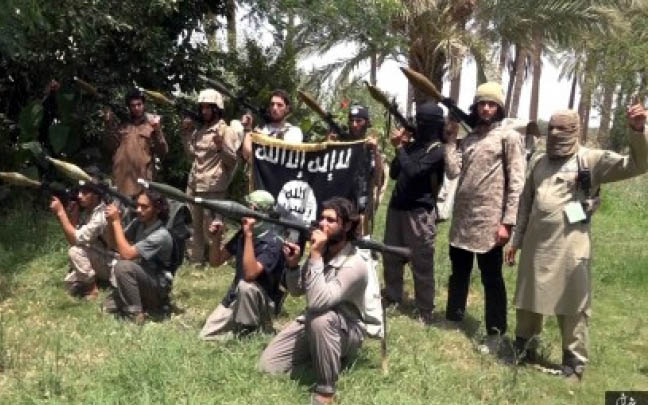The self-proclaimed Islamic State of Iraq and the Levant (ISIL) has changed to a menace for both Pakistan and Afghanistan. The ISIL group has aggravated the security situation and created a sense of fear in the air via practicing their radical ideology, which is deeply embedded in their hearts and minds. It is self-explanatory that violence and carnage run in the blood of ISIL fighters, therefore, they trample upon the rights and dignity of mankind on the grounds of one’s caste, creed and color. It is believed that as a result of the ISIL emergence in Afghan-Pak soil, the graph of civilian casualties increased and political instability escalated further.
In a recent statement, Pakistan’s director general of the Intelligence Bureau (IB), Aftab Sultan, said that ISIL emerged as challenge in Pakistan since the militant groups, particularly Sipah-i-Sahaba and Lashkar-i-Jhangvi, have soft corner for it. Though ISIL and Afghan Taliban were in conflict, the Tehreek-i-Taliban Pakistan (TTP) coordinated with it, he added. Following the denial of Pakistan’s interior ministry of ISIL’s emergence, he said that the IB had busted a big ISIL network after several members reached Punjab following Karachi’s Safoora Goth carnage in May. Mr. Sultan held the banned TTP responsible for major terror incidents in Pakistan and said the group had been realigning with Lashkar-i-Jhangvi and Sipah-i-Sahaba. He also mentioned killings of Superintendent of Police Chaudhry Aslam in Karachi and Awani National Party (ANP) leader Bashir Bilour in Peshawar.
Similarly, some members of Afghan Taliban pledged allegiance to the Al-Baghdadi’s caliphate. ISIL fighters gained firm foothold in Afghanistan and lately stoked sectarian violence. It is believed that the bloody episodes, which victimized ethnic minority groups and the recent hostage-takings, were carried out by ISIL fighters in the country. Hence, this group intends to trigger racial tensions and sectarianism among the nation – it will lead to a great instability and may sow the seed of hatred if not curbed on time. The already staggering Afghan casualty figures have soared to new heights after the international combat mission ended a year ago. The country suffered almost 5,000 civilian casualties only during the first half of 2015; nearly 30,000 Afghan soldiers and policemen were killed from 2009 to mid-2015. December saw a 57 percent rise in civilian casualties. With the emergence of ISIL fighters and their mysterious involvement in violence and bloodshed, people have lost their hope and desire for a peaceful life and a large number of Afghan citizens flocked to foreign countries. Political turmoil wrecked havoc on economy and unemployment reached its peak. In other words, the escalated militancy stagnated the economic cycle and ultimately paralyzed the whole financial activities. As a result, the bulk of the NGOs left the country and top traders and investors withdrew their money from the country. Since a number of university graduates failed to find job, brain-drain took place and this has added to the challenges. In short, the militants, including the ISIL fighters, have posed great threat to the country.
The insurgency seems to continue unabated, mainly after the emergence of the ISIL group. The Pakistani IB chief also warned that Pakistan could see more terror attacks because it was not possible to completely eliminate terrorists in the next decade.
Gen John Campbell, commander of the Resolute Support mission in Afghanistan, has said in his recent statement that the militants’ hideouts exited on both sides of the Durand Line. Pakistan and Afghanistan, therefore, should tackle the issue together, he added. “They’ve got to talk military-to-military on how they can get after a common enemy that knows no border, knows no boundaries,” Campbell is cited as saying. “Afghanistan is at an inflection point,” he told congressmen, acknowledging the war-devastated nation was yet to achieve an enduring level of stability that justified a cut in support. Whether he pursued terrorists into Pakistan or not, the general replied that he could not talk about the rules of engagement in an open forum. A better option than sending troops into Pakistan would be to train Afghan forces to fight the insurgents.
The US earlier designated the ISIL group’s affiliate in Afghanistan and Pakistan as a terrorist organization. The US State Department said the order concerned the Islamic State group’s “Khorasan Province” — which US officials refer to as “ISIL-K.” It said, “The group is based in the Afghanistan-Pakistan region and is composed primarily of former members of Tehrik-e Taliban Pakistan and the Afghan Taliban.” Based on the statement, the group pledged loyalty to the head of the Islamic State’s self-proclaimed “caliphate”, Abu Bakr al-Baghdadi, in January 2015. “ISIL-K has carried out suicide bombings, small arms attacks and kidnappings in eastern Afghanistan against civilians and Afghan National Security and Defense Forces, and claimed responsibility for May 2015 attacks on civilians in Karachi, Pakistan.”
Hence, both Afghan and Pakistani officials believe that ISIL is a common threat and gained foothold within the two countries. Moreover, rumor says that ISIL fighters will intensify their terrorist activities in coming spring inside the border – the same as the Taliban’s spring offensive and it would increase civilian casualties if not curbed on time. In a nutshell, this group will create greater challenges with the support of some Taliban members, who pledged loyalty, and help of Lashkar-i-Jhangvi and Sipah-i-Sahaba, as Sultan has mentioned. So, Afghan and Pakistan governments will have to combat ISIL fighters strongly and leave no room for their strength.
Home » Opinion » ISIL – A Threat to Afghanistan and Pakistan
ISIL – A Threat to Afghanistan and Pakistan
| Hujjatullah Zia

